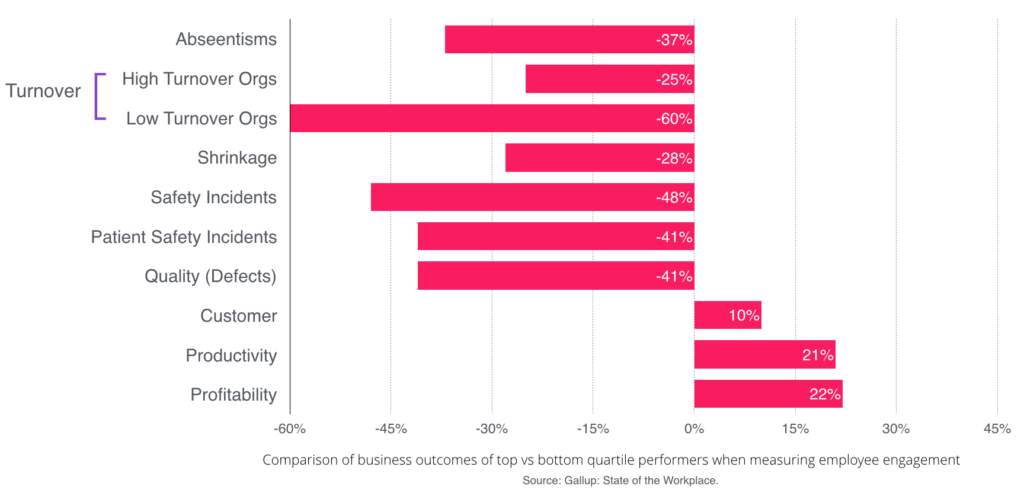Want to Improve Employee Engagement? Start Before Day One
But first, some context.
Why employee engagement matters
Employee engagement is no longer simply a fuzzy feel-good concept, or just a “good idea”. Organisations of all sizes are now awakening to the fact that employee engagement 1) is measurable 2) and has measurable consequences for both their operations and their bottomline.
In the Gallup study State of the Workplace, the researchers mapped employee engagement to business outcomes. Higher staff engagement led to improved customer engagement, productivity and profitability. Turnover, absenteeism and safety issues rose in line with a lack of employee engagement.
The results were clear:

“When businesses invest in talented managers and double their rate of engaged employees, they achieve about 150 percent higher earnings per share.”
Gallup
Employee engagement starts with a smooth recruitment-to-onboarding process
First impressions, pardon the cliche, matter.
When you think about it, employee engagement is really about the relationship that staff have with others in the company, be it their colleagues, managers, or the organisation as an entity.
At the risk of over-stretching the analogy, imagine arranging a romantic date with a prospective partner, but giving them the silent treatment in the week or so leading up to the date. That’s one way to sabotage the possibility of building a successful relationship.

It’s useful to think about engagement from the point of view of the employee. During the recruitment process, and in the lead up to the letter of offer, they build up a picture of the organisation that makes them want to work there. But once they have signed on the dotted line…silence.
A disconnected recruitment and onboarding process really sets the tone for the relationship down the line.
The first step to fostering employee engagement is to start with this. Keep up a level of communication (exciting communication…not just admin requests) to build excitement and advocacy even before a new hire has stepped in the door for their first day.
This will create engagement to:
- (hopefully) stop them from accepting an offer elsewhere before they start
- have them more ready to get stuck into their role when they begin
- establish the norm of employee engagement
Start Day One with a bang
OK, first of all, let’s just make sure we have the basic things lined up.
- Equipment ready
- The new hire’s manager is in the office
- The new hire’s manager knows about the new hire (this isn’t a joke, we’ve heard some stories!)
However, if you truly want to build employee engagement and advocacy for your new hires, go the extra mile. Here are some ideas to get you started:
- Perhaps through the interview or pre-boarding stages, hobbies or interests were discussed. Have the manager or team take a few minutes to add a personal touch to a desk or the team’s area
- Take over the screen in the reception with a welcome image for the new hire
Not only does this create a sense of belonging, it is also a great way to provide some free talent brand moments (we all love the LinkedIn posts showing just how great day 1 was).
Create an easier way to navigate the dreaded internal systems
So you’ve done a great job making the new hire feel engaged and welcomed, but after lunch or on the second day, it’s time to start getting into some company content.
Deep breath, followed by a sigh.
Every new hire dreads the mundane e-learnings, and most employers know how hard it is to navigate a learning system or intranet. In one survey, between 16-17% of the respondents left between the first week and the third month of starting their new job, so creating a smoother entry into the company goes a long way to increasing employee retention early on.
Rather than loosely telling a new hire where to go to access systems and content, why not drip feed specific links to locations to find content at different stages of the new hire’s first few weeks? Imagine as a new hire, on your third day – you have an email in your inbox directing you to relevant links? It will avoid any awkward moments of uncertainty or confusion, that’s for sure.
Get instant feedback with pulse checks
Quick quiz: when a new hire joins your company, what is your approach to their onboarding experience data?
A: What is onboarding experience data?
B: Don’t wanna know
C: We’ll collect it as part of the quarterly/bi-annual employee survey
D: We’ll collect that data at a predetermined time using a new starter/recruitment survey
If you answered A, B, or C, you might not be identifying problems until they are too late. Without over-engaging the new hire, it’s always a good idea to check in with them after their first week or month, so you can identify and rectify any budding issues, establish open lines of communication, and help the employee feel much more settled and engaged.
One point here though – if you do decide to survey at frequent intervals, it’s important to not just think about how you will gather the feedback, but how to action the feedback. Consider automated pulse check systems (including our own Enboarder, of course), which can automatically trigger an alert to a team member if the new hire has given a poor score during the survey.
Coach and enable managers to engage
Not surprisingly, the manager has a key role to play in ensuring new comers settle into their new role, and ensuring employee engagement. At the same time, managers may need coaching on just how they can go about engaging with their reports.
Start by educating managers on the importance of setting goals and KPIs, which will create an objective way for a new hire to understand how they are progressing in their role.
Managers also need to be made aware of the importance of frequent feedback. Prompt a manager to have one-on-one catch-ups at the end of the first week and month at a minimum. These catch-ups are an opportunity to both give and receive objective feedback, and explore new areas for development. Don’t under-estimate just how effective these sessions are in helping empower new hires. Armed with the knowledge of how they are tracking, and where they can focus their efforts on improving, they can forge ahead with clear goals in mind.
Moving the needle on employee engagement, turnover, and the bottomline
If you’re interested to see how onboarding can really move the needle on not just employee engagement, but a whole bunch of business metrics, then you will want to check out our FREE extended guide Why Onboarding Software? Building a Business Case for Employee Onboarding Technologies. We talk about the potential time and money savings for the onboarding process, as well as the impact on recruitment, turnover, engagement, and the bottom line. You can check it out here:
How onboarding affects business metrics 🎛
